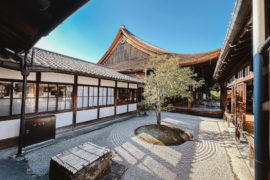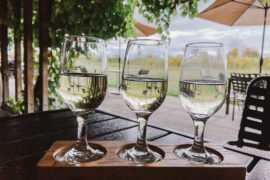When you think about Japan, wine is not necessarily the first thing that springs to mind. And yet, they’ve been making wine for more than 1,000 years, with numerous accolades to their name and a thriving wine industry. As a lover of underrated wine regions, the moment I discovered there was one a mere couple of hours away from Tokyo, I knew I had to go.
If you’re looking for a different type of day trip from Tokyo and a chance to get off the beaten path, and of course, try Japanese wine, then the Koshu Valley in Yamanashi is for you. In addition to boasting 70 wineries, this area is absolutely beautiful, framed by the Japanese Alps on one side and Mount Fuji on the other end.
This day trip is the perfect addition to a your Tokyo itinerary. Be sure to also check out this post on the top Japan travel tips you need to know for your trip.
👉 This post covers a DIY way to visit the wineries of the Koshu Valley. If you’re looking for a tour option, check out this half day tour.
This post may contain affiliate links. If you make a purchase using one of these links, I may receive compensation at no extra cost to you. Read my disclosure for more information. Thanks for supporting the blog!
What wine do they produce in Koshu Valley?
Grapes first found their way to Japan along the silk road, a thousand years ago. While the origins of formal wine production may be unclear, what is known is that it all began in Katsunuma (the focus of this day trip itinerary) in the very heart of the Koshu Valley. Fast forward to today, and this area is known for the Koshu grape and the Muscat Bailey A grape.
The Koshu grape produces a subtle white wine with light citrus aromas and a delicate flavor. It is a wine that pairs very well with Japanese food.
In recent years, Koshu wine has garnered international attention, as Japanese winemakers have fine tuned their wine making, resulting in high quality world-class wines. In fact, a Koshu wine picked up the gold medal in the 2021 International Wine Challenge.
The Muscat Bailey A grapes yield light, dry red wine that are also a perfect addition to a meal without dominating some of the more subtle flavors found in traditional Japanese cuisine.
You can also find international varieties in Koshu Valley such as Merlot, Cabernet Sauvignon, Pinot Noir, and Cabernet Franc as well as some more obscure Japanese grapes.
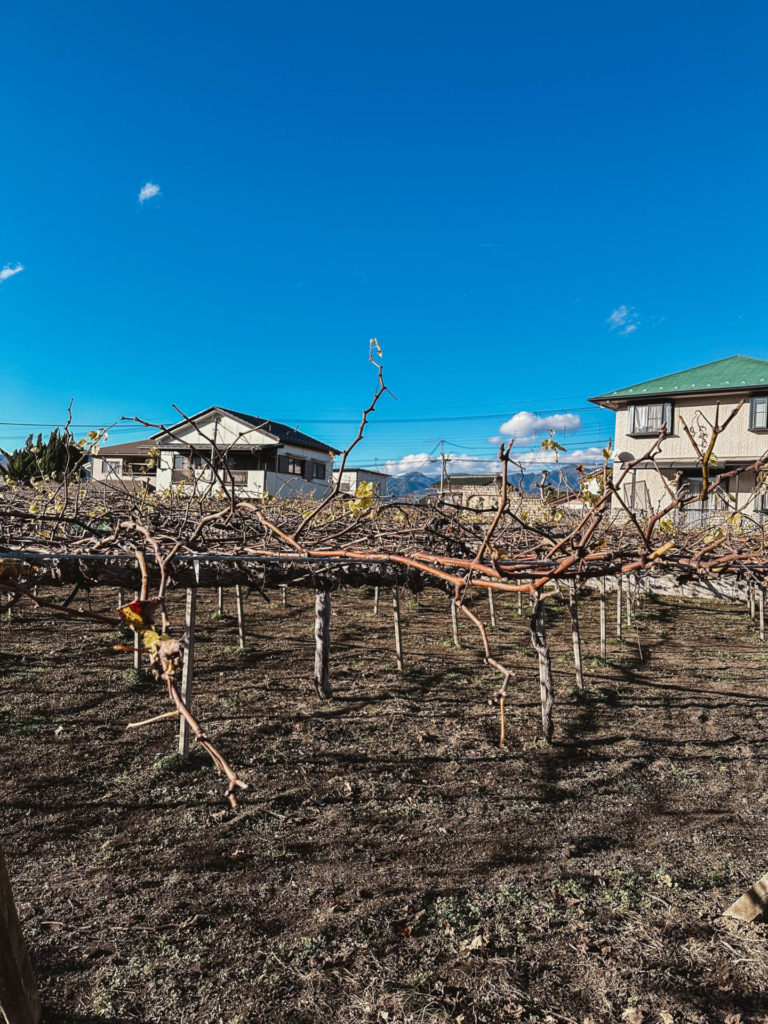
Day trip to Koshu Valley
When I was doing my research on spending a day in Koshu Valley, there was practically zero information online. Most people I talked to had never even heard of the Koshu Valley. The wineries themselves didn’t have much contact information available. Even if they did have a phone number, with my paltry amount of Japanese, I knew we wouldn’t be able to communicate very much.
Aka this was about to be an adventure. And I love nothing more than an adventure. I told my fiancé, Eric, that we very well could show up and not be able to try any wine at all given that we weren’t sure if we were allowed to just walk into the wineries or not. He was all about the adventure and we loved the idea of discovering somewhere that other travelers don’t frequent
As vegetarians, I wasn’t sure we’d be able to find anything for lunch once we got there so we went to a bakery in Tokyo and stocked up on a bunch of fresh goods and were ready to go. I would highly recommend you do the same if you’re a vegan or vegetarian.
We ended up having a fantastic day trip so keep reading for our experience visiting the Koshu Valley and our tips for planning a trip there yourself.

How to plan a trip to Koshu Valley
For somewhere so off the beaten path, you really don’t need to do a lot of advance planning.
The majority of the boutique wineries are within the central area of the town of Katsunuma so if you are doing a day trip, this is a great place to focus your time. You can walk between the wineries so it makes it easy to get from place to place.
We had a list of wineries I was interested in visiting but you don’t need to know all the wineries you want to visit ahead of time. I’d at least pick one winery to start off with and then you can easily pull up Google Maps and see what other wineries are nearby that you could walk to and that seems interesting to you.
We found it easy to simply walk into a winery and do a tasting. If you want to do a winery tour, I’d assume you’d need to contact them in advance to arrange this. None of the three wineries we visited were that busy. In fact we were the only ones in two of the wineries.
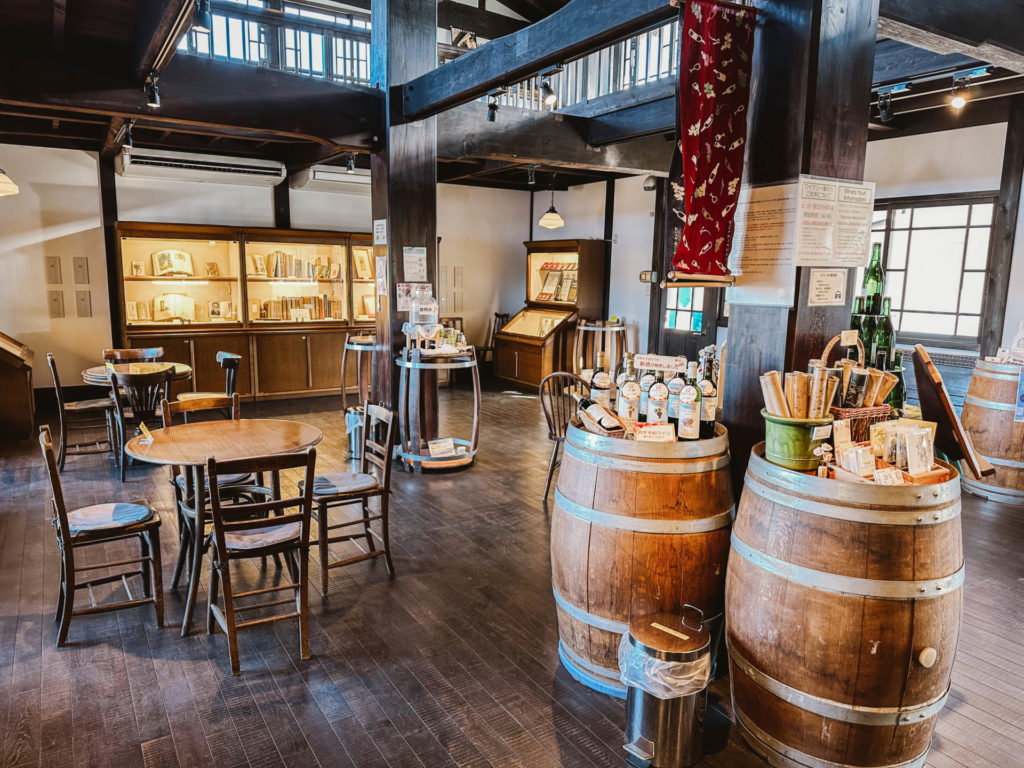
How to get to Koshu Valley
Logistics
The best time to start your day trip is sometime mid-morning so you can get there when the wineries open.
The best way to get to the Koshu Valley and the Katsunuma area from Tokyo is by bus or train. We opted to take the bus there because the bus stop got us within a 15 minute walk of our first winery. Given that we weren’t sure if taxis would be available, we wanted to be able to walk everywhere.
On the way back to Tokyo, the last winery called a taxi for us and we went to the train station and took the train to Shinjuku. This was much more straightforward than the bus route. The only issue is that if you’re arriving at the train station in Katsunuma, I’m not sure how easy it is to get a taxi. It wasn’t clear if there were ones waiting there or not. So I’d recommend taking the bus to Koshu Valley and then the train back if you want to be on the safe side.
You can easily use Google Maps to figure out bus and train options to Koshu Valley. For the most part, you will be going either from the Shinjuku station or the Shinjuku bus station. Be sure to also check when the last train/bus departs to head back to Tokyo.
Just be sure that you head to either station early. We headed to Shinjuku bus station with what we thought was plenty of time to spare (20ish minutes). Spoiler alert: it was not enough time.
Our experience
The Shinjuku bus station was chaotic and massive and it took us a while to figure out where the bus even was since it isn’t a bus commonly taken by tourists and everyone seemed pretty confused when we asked for it. Once we finally located it, we tried to buy tickets but, because by then the bus was leaving in two minutes, it didn’t allow us to buy tickets even though there were seats on the bus. We accepted defeat and purchased a ticket for the next bus.
The bus driver let us out at the bus station, which was at the side of a massive highway. So far so good. At least we made it to the right bus station.
I pulled the maps back up and looked at the walking route to the first winery. The problem: it was across the highway.
Eric and I looked at each other and were like how the hell do we get across? We took a bite of one of the baguettes we brought along and started wandering around the bus stop searching for a solution.
We could see the bridge that crossed to the other side but we couldn’t figure out how to get up to go to it. There had to be stairs somewhere.
We finally located the stairs but the gate was locked. Okay, maybe not getting off to the best start here.
We turned around and found another gate with a sign on it. After translating it said “keep the gate closed so the animals do not get out.” Eric and I stared at each other. Where were the animals!? What animals were we about to encounter on the side of the highway?
Taking our chances, we opened the gate and followed the dirt path up and around until we found the bridge! We cheered, took another bite of our carbs and kept going. There were no animals in sight, thankfully.
Takeaways
- Head to the bus station with enough time to navigate the chaos
- You can take the train depending on which winery you’re visiting but you will likely need to find a taxi once you arrive to take you to the winery
- If you take the bus to the Chuodo Shakado station and you’re facing the highway go left and open the gate at the edge of the station and then walk up to reach the bridge
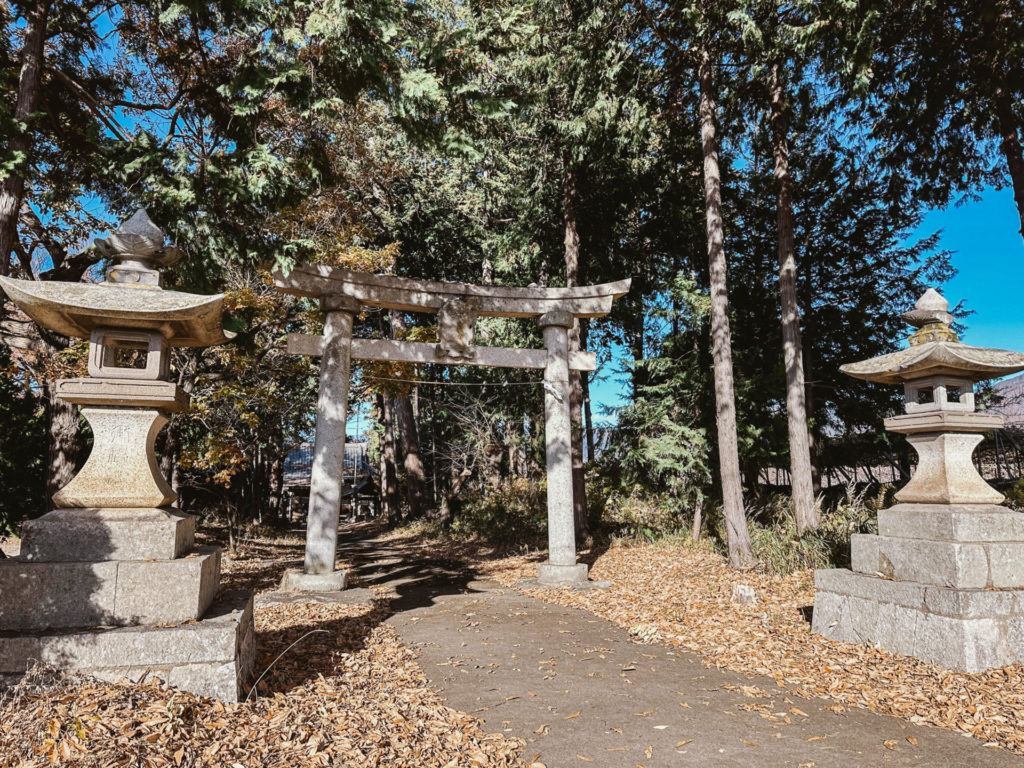
How to get to the vineyards
It’s very straightforward to walk between the vineyards and you’ll enjoy stunning vistas along the way.
After we escaped the bus station, we made our way across the highway and then started walking along the path the maps pointed us to. We were surprised to realize that the path snaked its way through the vineyards, so that with every step we took, we were surrounded by vines and a stunning view of the mountains in the distance.
We didn’t see another soul in sight and I could feel my spirits lifting. This is why I love to travel. To discover little hidden gems like this. I inhaled deeply, feeling the cool mountain air fill my lungs and I could feel myself trying to take in all the sights at once. Juxtaposed against bustling Tokyo, this was a little slice of serenity.
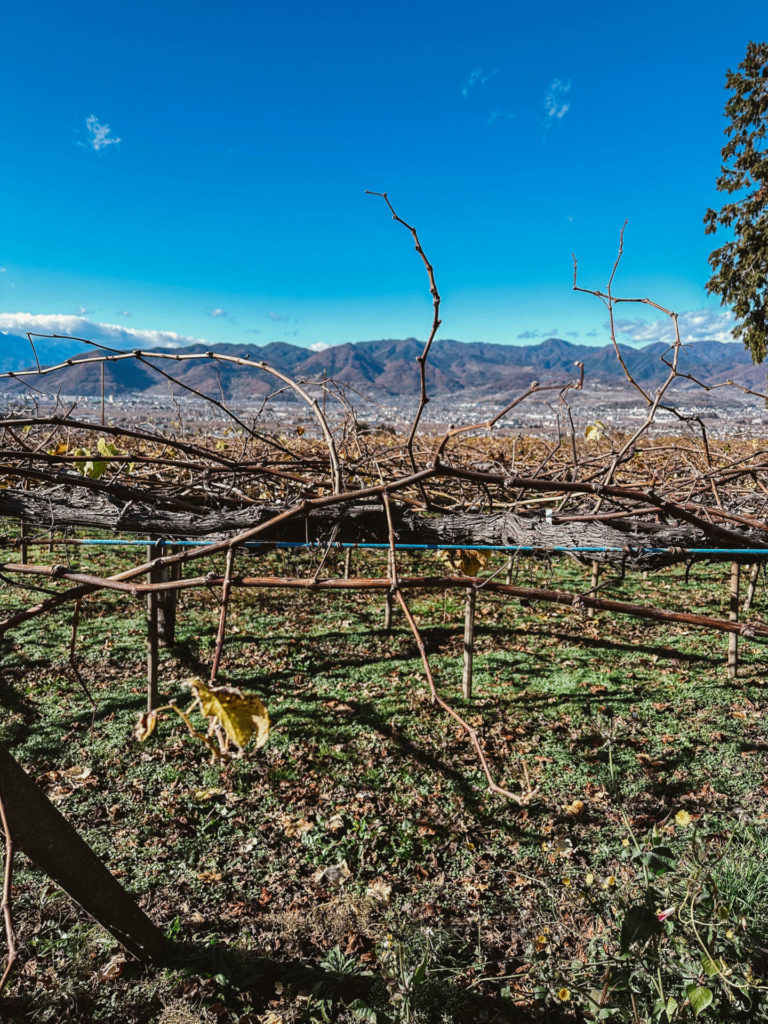
Our experience tasting at the wineries
Marufuji Wine
Our first stop was at Marufuji Wine and we were able to walk right into the wine shop. The lady behind the counter didn’t speak any English but I mimicked the action of drinking wine and she immediately produced a menu of our options. We selected a tasting flight and she poured the wine into these little plastic cups.
The wines we tasted were just okay. I’m not sure if it was the fact that we were drinking out of plastic cups or that I felt the wines she poured lacked depth of flavor. Either way, I’d say this winery is skippable.
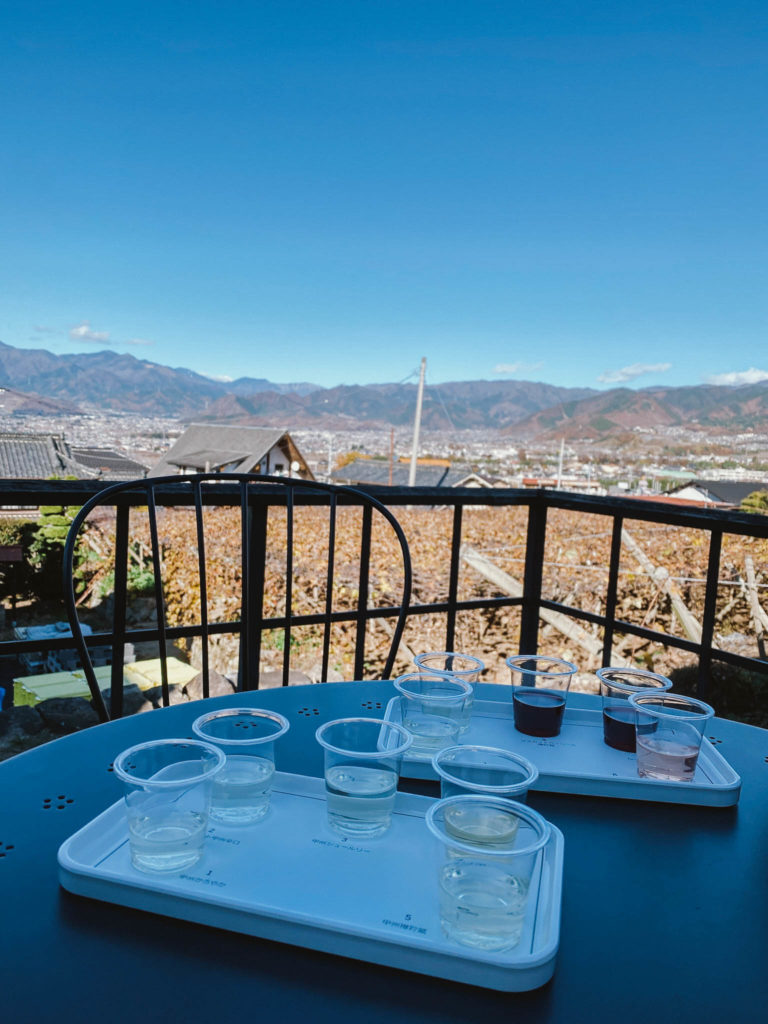
Lumiere Winery
We walked to the next winery and ate some more of our yummy treats we had brought along with us. We again didn’t see anyone on our way to the next winery and the walk was very pleasant.
This winery was my favorite of the three and there were quite a few high quality wines we enjoyed and overall, they had some good wine.
The way the tasting works here is that they give you a card and a couple of wine glasses. You then go up to any wine that looks interesting and select the pour size you want and tap your card. You then go back to the tasting room and enjoy your wine before heading back for more pours. The card tallies up your balance and you pay at the end. This was a really fun way to taste as many wines as we wanted and to go back and re-taste some of our favorites.
There is also an onsite restaurant. After a quick translation of the menu, it didn’t look like there were many vegetarian options but it did seem like they had some good food for omnivores. If you aren’t a vegetarian, you might want to consider doing lunch here as I think it would add greatly to the experience. I’d recommend trying to make a reservation for lunch in advance to be on the safe side. You can always ask your hotel back in Tokyo to help you do so.
Katsunuma Winery
The final winery we visited was Katsunuma winery which had quite a few different wine options, including sparkling wines available to taste.
They had a stunning view of the vineyards and the mountains in the back so we took our pours outside and thoroughly enjoyed spending time here. As we sipped, we kept on marveling at how wonderful our little day trip turned out.
Like Lumiere they had a card system as well though this one wasn’t quite as well done as you had to pre load the card vs paying by consumption and you had to pay a fee for the card itself.
I also found the wines here to be better than the first winery but not as great as Lumiere. I think the main appeal of Katsunuma winery is its stunning surroundings and laid back atmosphere. It’s a great place to spend an afternoon.
If you go here, don’t miss a visit to the rooftop for some beautiful views. They were also kind enough to call us a taxi to head to the train station (they spoke English well here).
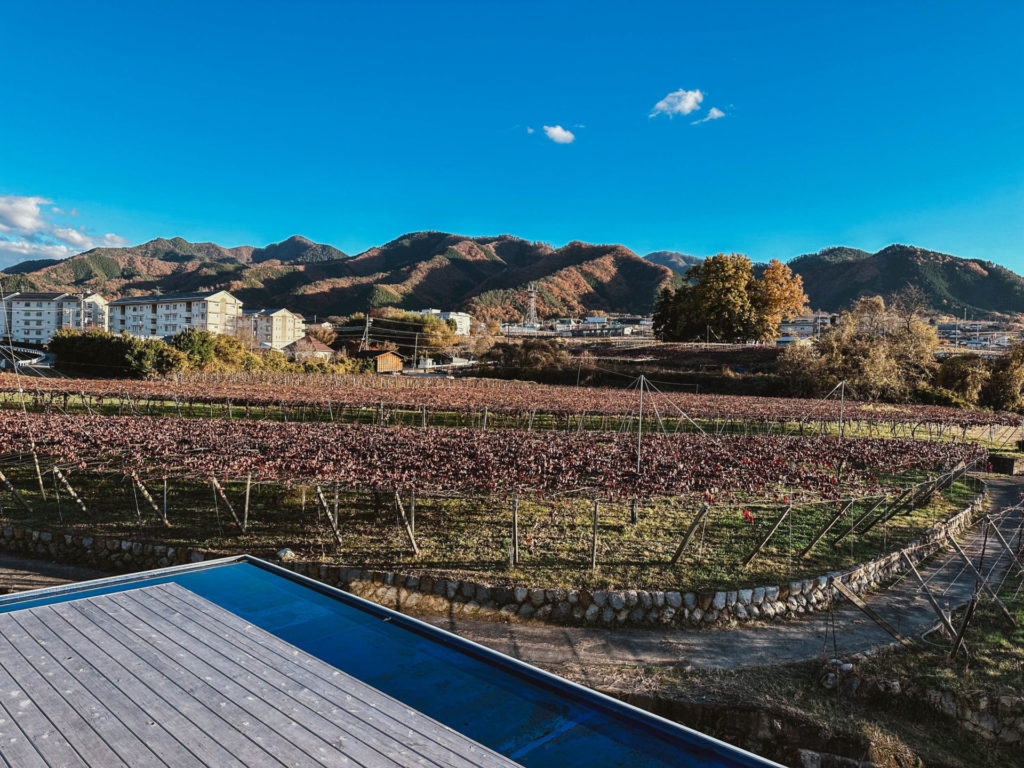
Bottom Line
Wine lovers, look no further than the Yamanashi prefecture. A day trip to this wine region is a great way to try the local wines made of Koshu grapes. It is quite a bit off the beaten path so just be prepared to go with the flow. I also recommend carving in some time to just walk around and take in the beautiful surroundings. Trust me, you’re going to fall in love with this area!
Liked this post on the Koshu Valley? Then you’ll love these:
Pin this post on the Koshu Valley for later







